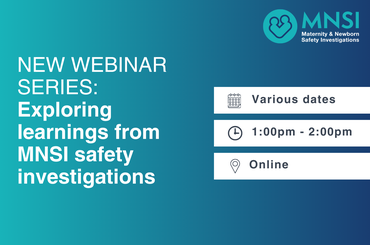
Louise has been a Maternity Investigator for five years, having previously worked in clinical and patient safety roles. She currently works for the Maternity and Newborn Safety Investigations (MNSI) programme. In the time between developing this tool and writing this article, guidance to assist with interviews following a patient safety incident was published by NHS England and the Healthcare Safety Investigation Branch (HSIB).
In my early years as a maternity investigator, when interviewing staff about patient safety incidents, I found that at times the quality and depth of information obtained did not fully answer all the whys around decision making at the time of an incident.
This left me with two options: to repeatedly ask similar questions around the same area, at the risk of staff feeling interrogated and worried they had done something wrong; or to come away with unsatisfactory information for the investigation. Neither option sat right with me, so to address the problem I set out to develop my interviewing style.
This blog lays out my journey to obtain higher-quality information from interviews while protecting staff involved in patient safety incidents.
Whilst the impact of a patient safety incident is often devastating for patients and families, the emotional effects on staff involved are also well documented (Wu and Steckelberg, 2012). So how do we ask questions that explore local rationality and let us really understand why a decision, action or inaction made sense at the time without making staff feel interrogated or blamed?
As a starting point, I carried out a review of safety science literature. I found an almost overwhelming amount of information, which I streamlined and collated into a table of questions (see below) that would help an investigator explore local rationality. For me, the tool needed to be functional, easy to navigate, and suitable for use in daily work when planning interviews.
I structured the questions according to the tell, explain, describe (TED) approach of effective questioning, altering the wording when needed to ensure questions did not appear accusatory. I categorised the questions into areas for focus, relating to a situation, thoughts/decision making, preparedness (knowledge and training), communication, and anticipation/thinking ahead. Supporting information within the table makes it easier to select the type of questions needed to get the right information.
For the past three years, I have embedded this tool into my practice as an investigator and have observed how interviews flow better and feel more like a discussion. The quality of information obtained leads back to system or process issues, or that deviation from usual practice occurred, due to other influencing factors. I feel more comfortable during interviews, as I know that the questions I am asking are not focusing on the person. At the end of interviews staff reported that it was “not a scary interview” but a “pleasant experience”. Some staff have shared how they were initially worried and nervous but instead came away having had a positive experience and greater awareness of our intentions and purpose of improving healthcare services for future families and staff.
I had envisaged the use of these questions becoming automatic the more I used them, and whilst that is the case to a certain degree when I draw from the questions in live interviews, I still use the tool during interview planning to make sure that I am selecting the right type of questions for the information I need. Given that each investigation is different due to ever-changing variables, taking time to consider the questions being asked before an interview, and reflecting on the information shared by staff in response, is always encouraged.
Given the breadth of possible lines of questioning, it is important for the investigator to choose questions that draw out meaningful and relevant responses and provide what we want to know. Asking the right questions enables findings to be more accurate, which is ultimately the basis for making the right recommendations for change.
Whilst the focus of an investigation should be on systems, processes and human factors, we know that, due to the nature of the work, healthcare staff will often individualise blame on themselves when an incident occurs. Our role as the investigator is to ensure that we don’t add to this further by the way that we ask questions. Often the way that we ask a question can stay with staff long after the interview has finished. We have the ability, through the questions we ask, to take it away from the person and show them that it’s about the information that was available at the time, influencing human factors, and the systems, processes, and situation they were working within, that we are really interested in.
Whether you’re new to healthcare investigations, or you have worked in this field for some time, it is hoped that this tool may offer some help to really understand why it made sense at the time, whilst being mindful of the emotional impact on staff.
To download and print Louise's local rationality questions table as a PDF, click the below button, or view the table in full below.
Exploring situation in local rationality questioning
| Question | Comments | Based on (reference) |
|---|---|---|
|
Describe to me what was happening at the time? |
Allows exploration of dynamic elements of a work environment. | Dekker, 2014; Patel et al, 2002 |
| Describe to me what was happening around you? | How did the situation unfold around them; what cues did they get when? | Dekker, 2014 |
| If you had to describe the situation to your colleague at that point, what would you have told? | Klein,1998 | |
| Describe to me what you were seeing/hearing? |
Dekker, 2014; Klein, 1998; Hoffman et al, 1998 |
|
| Tell me what the workload was like for yourself and those around you during this time? |
Workload intensity or inactivity. Helps to explore fatigue and stress as well. Were their multiple goals at the same time? |
Dekker, 2014; Patel et al, 2002 |
| Can you tell me about any time pressures to complete tasks or any limitations on what you were able to do at that time? | Workload intensity. | Klein,1998; Hoffman et al, 1998 |
|
Tell me about any reassessments of the situation? |
Immediate feedback, careful monitoring and assessment of the situation. Shifting goals as patients condition changes and new problems/complications arise. | Klein, 1998; Patel et al, 2002 |
| Can you breakdown... (name the task) into three to six steps. Of these steps, tell me a bit about those that required assessment/decision making/problem solving, if any. | Complete task diagram for very complex procedures/situations. This can provide road map and inform subsequent interviews. Helps to explore situations with dynamic quality to them. |
Militello and Hutton, 1998; Patel et al, 2002 |
Exploring thoughts and decision-making in local rationality questioning
| Question | Comments | Based on (reference) |
|---|---|---|
| Describe what you were focusing on? | Klein, 1998 | |
| Can you explain what your aim (goal) was during this time? | Not knowing the outcome, you now know about now. Selecting information to confirm their current hypothesis rather than explore others. | Dekker, 2014; Pitz and Sachs, 1984 |
|
Tell me what was the aim when undertaking… |
What were they trying to achieve. | Klein, 1998; Hoffman et al, 1998 |
| Can you tell me about any previous experiences you have had in similar situations? | Pattern matching – always previously turned out OK, never been in situation before to anticipate outcome. |
Klein, 1998; Mitchell 2013; Hoffman et al, 1998; Patel et al, 2002 |
| Can you tell me what options were considered or available for managing... or does this situation fit into a standard scenario | Klein, 1998; Hoffman et al, 1998 | |
| Tell me about what information you used to help you make this decision? …how did you obtain this information? … tell me about any barriers you had obtaining this information? | Was all the information available to you to help you make the decision. |
Hoffman et al, 1998; Adapted from Klein et al, 2010 |
| Can you explain to me what information you would need to make …decision? | Was all the information available to you to help you make the decision. | Adapted from Klein et al, 2010 |
| Were there any other options available at the time that should have been? | Adapted from Klein et al, 2010 | |
|
Can you tell me what level of experience would be required to make this decision? |
Adapted from Klein et al, 2010 | |
| For staff less experienced, describe to me what guidance/aids there are to help them make these decisions? | Adapted from Klein et al, 2010 |
Exploring preparedness, communication and anticipation in local rationality questioning
| Question | Comments | Based on (reference) |
|---|---|---|
| Can you tell me a bit about the training that you/staff have to deal with this situation? …What training, knowledge, or information might have helped? | Klein, 1998; Hoffman et al, 1998 | |
|
Tell me what guidelines/policies there are in your unit to help manage this situation? |
Any rules that applied clearly here | Klein, 1998 |
| Can you tell me about any other sources of knowledge (staff, aids) you used to help you with this situation? | Application of knowledge - processing of knowledge, usable for situation, apply in correct context – was the right knowledge present for that situation. | Klein, 1998 |
| Describe how the team communicated to each other during this time? | Communication patterns in team performance. | Patel et al, 2002 |
| Describe what you were expecting to happen? | Thinking ahead. Would also answer (did outcome fit expectation) | Klein, 1998 |
| Can you explain to me what you were hoping would happen as a result of… | Imagined possible consequences of action. How were they imagining events would unfold. How did they judge they could influence the course of events? | Hoffman et al, 1998; Klein, 1998 |
| What could possibly happen at this point? | What mistakes/slips were likely at this point? Don’t use the word mistake when speaking to staff. | Klein, 1998 |
References
Dekker, S. (2014) The field guide to understanding ‘human error’, third edition. Surrey: Ashgate Publishing Limited.
Hoffman, R.R, Crandall, B. and Shadbolt, N. (1998) Use of the critical decision method to elicit expert knowledge: A case study in the methodology of cognitive task analysis. Human Factors, 40 (2), 254-276.
Klein, G., Calderwood, R. and Clinton-Cirocco, A. (2010) Rapid decision making on the first ground: the original study plus a postscript. Journal of cognitive engineering and decision making, 4 (3), 186-209.
Klein, G.A (1998) Sources of power: How people make decisions. Cambridge: MIT Press.
Militello, L.G. and Hutton, R.J.B. (1998) Applied cognitive task analysis (ACTA): a practitioner’s toolkit for understanding cognitive task demands. Ergonomics, 41 (11), 1618-1641.
Mitchell, P. (ed.) (2013) Human factors for healthcare: Trainers manual. Cove: Swan and Horn.
NHS England and Healthcare Safety Investigation Branch (HSIB). (2023) Guidance on planning and conducting interviews as part of a patient safety incident learning response. Available online here.
Patel, V.L., Kaufman, D.R. and Arocha, A.F. (2002) Emerging paradigms of cognition in medical decision-making. Journal of biomedical informatics, 35, 52-75.
Pitz, G.F. and Sachs, N.J. (1984) Judgement and decision: theory and application. Annual review of psychology, 35, 139-163.
Wu, A.W. and Steckelberg, R.C. (2012) Medical error, incident investigation and the second victim: doing better but feeling worse? BMJ Quality and Safety, 21(4), 267-270.
Related news
MNSI responds to the publication of the NHS 10 Year Plan
MNSI responds to maternity and newborn safety announcement 23 June 2025
